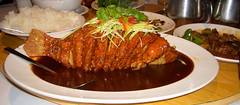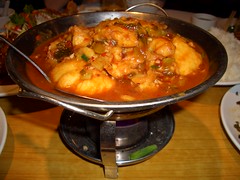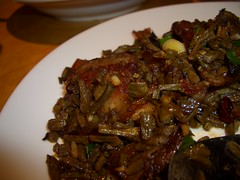A coworker of mine from China recently said she went to a great Hunan-style restaurant. I was intrigued, since I had never eated authentic Hunan food (as far as I knew). Tell me more, I said. She said it was very authentic, and it was in St. Marks Place. Really? I didn't know any good Chinese place was there, besides the Grand Sichuan which I once at at. But, there is much I don't know about St. Marks Place, since it's never been very convenient for me to go there.
She took all of us there, and I discovered the Hunan place was...
Grand Sichuan! But wait, Grand Sichuan specializes in Sichuan, not Hunan. She insisted the Chinese name of the restaurant was different, and this restaurant is really of no relation to the other ones. I'm not sure if I believed it, but I tried it.
So, this was a Grand Sichuan, and one I've eaten at before. But, unlike others, it had an extensive Hunan menu. She ordered a variety of dishes, and out they came.
One of the things we had to try was the
stinky tofu, which is a pretty hard thing to find in Chinese restaurants. The problem usually is that the tofu stinks enough to annoy the people at the other tables, which isn't generally good for business. Grand Sichuan handled this well, serving us a stinky tofu that was noticably stinky, but not overwhelmingly so. If it were represented by a cartoon, the brown stink lines would only extend six inches or so. As with good stinky tofu, the inner was creamy and mild tasting.
Another interesting dish we got was preserved beef with sour-tasting green beans. Evidently preserved meats are a very important part of Hunan food. This dish was very well done, with the strong preserved meat being offset by the tang of the green beans. The combination was unusual for western palates, but it didn't take long to adjust and enjoy.

A particularly beautiful dish was a sweet & sour fish, sliced in such a way to fan out. The sweet & sour sauce was more sour, with a pungent dark vinegar bite to it. The fish was very well cooked, with sweet moist, tender flesh.

Another odd dish was a winter melon in a light sauce, with a few peppers adding some bite. The whole dish was fairly mellow with a subdued taste compared to the other Hunan dishes. but I liked its texture and the use of the winter melon.

The menu had several dishes consisting of a little wok held over a burner, making a nice bubbling concoction. This particular one was fish in a spicy sauce that was also a bit sour. It taste just like it looks: hot and stimulating, the kind of food that will spur you to eat as much of it as you can regardless of how full you are.
We had a few other dishes, including a nice dou miao (pea sprouts), and another dish I can no longer recall.
All these dishes added up to a great introduction to Hunan food. I've realized I've eaten many of these things in Little Sichuan, a restuarant in San Mateo, CA that I used to frequent. I just never knew that they were Hunan. Hot and sour seemed to be the predominant flavors, and they really worked well together. I'm eager for more, and I'm also interested to learn the differences between the various Grand Sichuan locations. Do some really specialize in different cuisines? I'll let you know if I ever find out.




